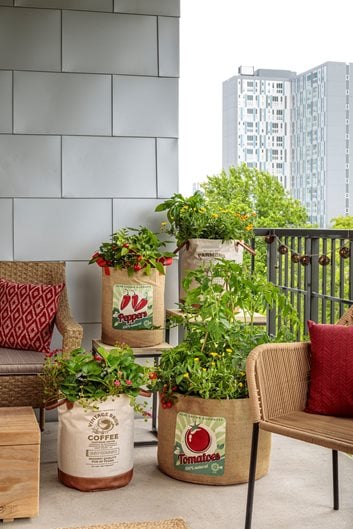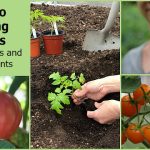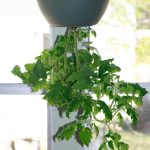To grow tomatoes in small spaces, utilize container gardening techniques and choose compact tomato varieties suited for limited areas. Expand your knowledge with the following tips.
Growing your own tomatoes can be a rewarding experience, even if you have limited space. Whether you have a balcony, tiny backyard, or just a small area, you can still enjoy fresh, homegrown tomatoes. By using container gardening methods and selecting compact tomato varieties, you can make the most of your space.
This article will provide you with valuable tips and insights for successfully growing tomatoes in small spaces. Get ready to harvest your own flavorful, juicy tomatoes, right from the comfort of your own home.
Choosing The Right Tomato Varieties
When it comes to growing tomatoes in small spaces, choosing the right tomato varieties is crucial. Not all tomatoes are created equal, and some are better suited for compact gardens or container growing than others. In this article, we will explore two key factors to consider when selecting tomato varieties for small spaces.
Determinate Or Indeterminate: Picking The Best Type
One of the first decisions to make when choosing tomato varieties for small spaces is whether to go with determinate or indeterminate types. Determinate tomatoes are considered bushy and have a more compact growth habit. They typically grow to a predetermined height, set their fruit all at once, and then decline. Indeterminate tomatoes, on the other hand, are known for their vining growth habit and can grow indefinitely if provided with proper support. They produce fruit continuously throughout the growing season.
While both determinate and indeterminate tomato varieties can be suitable for small spaces, it’s important to consider the available vertical or horizontal space you have. If you have limited vertical space, determinate tomatoes may be a better choice as they tend to require less staking or trellising. On the other hand, if you have ample vertical space and want to maximize your harvest, indeterminate varieties may be the way to go.
Compact And Bushy Varieties: Ideal For Small Spaces
In addition to determining whether you want determinate or indeterminate tomatoes, it’s also worth considering compact and bushy varieties when growing in small spaces. These tomatoes are specifically bred to have a more dwarf-like growth habit, making them perfect for containers, raised beds, or small garden plots.
Compact and bushy tomato varieties are known for their shorter stature and ability to thrive in confined spaces. They have a more spreading growth habit and don’t require extensive pruning or support structures. This makes them easier to manage and perfect for small-space gardeners.
Here are some popular compact and bushy tomato varieties well-suited for small spaces:
| Variety | Growth Habit | Best Uses |
|---|---|---|
| Roma | Determinate | Containers, small gardens |
| Cherry Cascade | Indeterminate | Hanging baskets, vertical gardens |
| Patio Princess | Determinate | Patios, balconies |
These varieties, among others, are bred to be more compact while still producing flavorful and abundant tomatoes. They can thrive in smaller spaces and offer a solution for gardeners with limited room to grow.
Whether you choose determinate or indeterminate varieties, or opt for compact and bushy tomato types, selecting the right tomato varieties is essential for success in growing tomatoes in small spaces. Consider the growth habit, space availability, and your specific gardening goals to choose the varieties that will thrive in your limited gardening area.
Optimizing Soil And Containers
When it comes to growing tomatoes in small spaces, optimizing the soil and choosing the right containers is crucial. The quality of the soil and the containers you use can make a significant difference in the growth and productivity of your tomato plants. In this section, we’ll explore how to prepare a nutrient-rich soil mix and select the perfect containers, considering the size and material.
Preparing Nutrient-rich Soil Mix
One of the key factors in successfully growing tomatoes in small spaces is preparing a nutrient-rich soil mix. Tomatoes are heavy feeders and require well-balanced soil that provides essential nutrients for their growth. Here are a few tips for creating a nutrient-rich soil mix:
- Start with a high-quality potting mix:
- Add compost for added nutrients:
- Consider adding slow-release fertilizer:
- Maintain proper pH levels:
A good potting mix is the foundation for healthy tomato plants. Look for a mix that is specifically formulated for container gardening and contains a balanced blend of organic matter, perlite, and vermiculite.
Compost is an excellent source of organic matter and nutrients for tomato plants. Mix in a generous amount of compost into the potting mix to enrich it with nitrogen, phosphorus, and potassium. This will help promote vigorous growth and fruit development.
Slow-release fertilizers are a convenient way to ensure your tomato plants receive a steady supply of nutrients over time. Follow the manufacturer’s instructions to determine the right amount to add to your soil mix, based on the size of your containers.
Tomatoes prefer slightly acidic soil with a pH level between 6.0 and 6.8. Use a pH testing kit to monitor and adjust the pH level if necessary. Adding lime to increase alkalinity or sulfur to lower acidity can help maintain the ideal pH range for your tomatoes.
Selecting The Perfect Containers: Size And Material
Choosing the right containers is essential for growing tomatoes in small spaces. Consider the following factors when selecting your containers:
- Size matters:
- Ensure proper drainage:
- Material matters too:
- Consider vertical options:
Tomato plants need enough space for their roots to grow and spread. Select containers that are large enough to accommodate the root system of the plants. A general rule of thumb is to choose containers with a minimum of 5 gallons (19 liters) capacity for each tomato plant.
Good drainage is crucial for healthy tomato plants. Look for containers with drainage holes at the bottom to allow excess water to escape. Additionally, consider placing a layer of rocks or gravel at the bottom of the containers to prevent waterlogging.
Containers can be made from various materials, each with its own advantages and considerations. Clay and terracotta pots are popular choices as they provide breathability and help regulate moisture levels. Plastic containers are lightweight, durable, and retain moisture well. Whichever material you choose, make sure it is suitable for the specific needs of your tomato plants.
If you have limited horizontal space, consider using vertical containers or hanging baskets. These options allow you to maximize the use of vertical space and grow tomatoes upwards, saving valuable space in small gardens or balconies.
Providing Optimal Growing Conditions
When it comes to growing tomatoes in small spaces, providing optimal growing conditions is crucial. Ensuring that your tomato plants get sufficient sunlight, proper watering and drainage, as well as temperature and humidity considerations, can make all the difference in the health and productivity of your plants. In this article, we will delve into each of these factors and provide you with practical tips to help you achieve the best results.
Ensuring Sufficient Sunlight
To promote the growth of healthy and robust tomato plants, it is essential to ensure that they receive enough sunlight. Tomatoes are sun-loving plants, and they thrive in full sun exposure. Aim to provide them with at least 6-8 hours of direct sunlight daily. If your small space lacks sufficient sunlight, consider using reflective surfaces such as mirrors or white sheets to redirect sunlight onto your plants. Additionally, placing your tomato containers near south-facing windows or using artificial grow lights can also provide the necessary light intensity for their growth.
Watering And Drainage: The Key To Healthy Plants
Proper watering and drainage are crucial for maintaining the overall health of your tomato plants. Tomatoes require consistent moisture levels, and overly dry or excessively wet conditions can lead to various issues like blossom end rot or root rot. To ensure effective watering, it’s recommended to water your plants deeply and thoroughly but only when the top inch of soil feels dry to the touch. This helps promote deep root growth. Remember to water the base of the plants and avoid wetting the foliage to minimize the risk of diseases.
Additionally, having good drainage is equally important. If you’re using containers, ensure they have drainage holes at the bottom to allow excess water to escape. Placing a layer of gravel or rocks at the base of the container can help facilitate proper drainage. Regularly check the drainage holes to ensure they are not clogged, as poor drainage can suffocate the roots and lead to root rot.
Temperature And Humidity Considerations
Tomatoes thrive in warm temperatures, typically between 70-85°F (21-29°C). It’s important to keep your plants within this temperature range to optimize their growth. If your small space is prone to cooler temperatures, consider using season extenders such as cloches or row covers to protect your plants from cold snaps or frost.
Furthermore, tomatoes also prefer moderate humidity levels. High humidity can lead to fungal diseases, while low humidity can cause dehydration in the plants. To maintain optimal humidity, you can place a tray filled with water near your plants or use a humidifier in the indoor growing environment.
Remember that different tomato varieties have specific temperature and humidity preferences, so it’s important to choose varieties that are suitable for your local climate and small space.
Planting And Caring For Tomato Plants
When it comes to growing tomatoes in small spaces, proper planting and care techniques are crucial for successful and bountiful harvests. Whether you choose to start from seeds or transplants, understanding the pros and cons, as well as knowing how to space and prune your tomato plants, and providing them with the right nutrients and fertilization schedule, can make a significant difference in the health and productivity of your plants. Let’s dive deeper into these essential aspects.
Starting From Seeds Or Transplants: Pros And Cons
When starting your tomato plants, you have two primary options: starting from seeds or using transplants. Each method has its own set of advantages and considerations.
Starting from Seeds
Starting tomatoes from seeds allows for greater control over the entire growth process and a wider selection of tomato varieties. It also gives you the opportunity to save money by avoiding the cost of purchasing transplants. However, this method requires more time, as tomatoes grown from seeds generally take longer to reach maturity.
Using Transplants
Using transplants, on the other hand, allows you to have mature plants ready for planting in a shorter amount of time. This can be particularly beneficial if you have a short growing season or limited time available for gardening. Transplants are also more resistant to adverse weather conditions and diseases. However, the selection of tomato varieties may be more limited, and purchasing transplants can be more expensive.
Proper Spacing And Pruning Techniques
To maximize tomato plant health and yield in small spaces, it is crucial to pay attention to proper spacing and pruning techniques. Tomatoes need adequate space for air circulation and sunlight exposure to prevent diseases and encourage productivity.
When planting tomatoes, ensure they are spaced according to the recommended guidelines for the specific variety you are growing. Generally, determinate varieties require around 2 to 3 feet of space between plants, while indeterminate varieties typically need 3 to 4 feet of space.
Pruning tomato plants is also essential to promote better airflow, reduce the risk of diseases, and focus energy on producing more fruit. Regularly remove suckers, the side shoots that grow in the leaf axils, to encourage vertical growth and sturdy stems. However, be cautious not to over-prune, as this can lead to reduced fruit production.
Nutrients And Fertilization Schedule
Nutrients are vital for healthy tomato plants, and providing them with a proper fertilization schedule is key. Before planting, amend the soil with organic matter, such as compost or well-rotted manure, to improve its fertility and nutrient content.
Once your tomato plants are established, feed them with a balanced tomato fertilizer, following the manufacturer’s instructions. The fertilizer should have a higher potassium (K) content to promote fruit development. Apply the fertilizer evenly around the base of the plants, avoiding direct contact with the stems to prevent burning.
To ensure a continuous supply of nutrients, it is essential to regularly fertilize your tomatoes. Generally, applying a liquid fertilizer every two to three weeks during the growing season is recommended. However, always monitor your plants’ specific needs and adjust the fertilization frequency accordingly.
Managing Pests And Diseases
Growing tomatoes in small spaces can be a rewarding experience, but it’s important to be prepared for potential challenges like pests and diseases. In this section, we will discuss common tomato pests and how to prevent them, as well as organic pest control methods. We will also cover recognizing and treating tomato diseases, so you can ensure your plants stay healthy and thrive in your small space garden.
Common Tomato Pests: Identification And Prevention
Identifying common tomato pests early is key to preventing their infestation and potential damage to your plants. Below are a few of the most common tomato pests:
| Pest | Identification | Prevention |
|---|---|---|
| Aphids | Tiny insects found on the undersides of leaves and stems; can be green, yellow, or black. | 1. Regularly inspect plants and remove any infested leaves. 2. Introduce beneficial insects like ladybugs or lacewings to control aphid populations. 3. Use insecticidal soaps or neem oil as a natural deterrent. |
| Whiteflies | Small, white flies found on the undersides of leaves, causing wilting and yellowing. | 1. Remove heavily infested leaves or plants to prevent spreading. 2. Place sticky traps nearby to catch adult whiteflies. 3. Use organic sprays like pyrethrum or insecticidal soap for control. |
| Hornworms | Large green caterpillars with horn-like projections often hidden on lower foliage. | 1. Inspect plants regularly and handpick any hornworms. 2. Encourage natural predators like wasps and birds. 3. Apply organic insecticides containing Bacillus thuringiensis (Bt) as a last resort. |
By identifying these common tomato pests and taking preventive measures, you can protect your plants and promote a healthy growing environment in your small space garden.
Organic Pest Control Methods
When it comes to managing pests in your small space tomato garden, organic pest control methods can be a safe and effective solution. Here are a few organic pest control methods to consider:
- Companion Planting: Planting insect-repellent herbs like basil, marigold, or mint near your tomato plants can deter pests.
- Biological Control: Introducing beneficial insects like ladybugs or predatory mites can help control pest populations naturally.
- Homemade Sprays: Create your own natural sprays using ingredients like garlic, hot pepper, or soap to repel pests.
- Physical Barriers: Use floating row covers or netting to protect your tomato plants from pests while allowing air and sunlight to reach them.
Implementing these organic pest control methods not only helps keep your tomatoes healthy but also promotes a balanced ecosystem in your small space garden.
Recognizing And Treating Tomato Diseases
Tomato plants are susceptible to various diseases, which can be detrimental to their growth and productivity. It’s important to recognize the early signs of these diseases and take appropriate action. Here are a few common tomato diseases:
- Early Blight: Identified by dark brown or black spots on leaves and stems, eventually leading to leaf yellowing and plant decline.
- Late Blight: Caused by a fungus and identified by dark, water-soaked lesions on leaves, stems, and fruits.
- Tomato Fusarium and Verticillium Wilts: These wilts cause yellowing and wilting of lower leaves, progressing upward.
If you notice any signs of these diseases in your tomato plants, it’s essential to take immediate action. Remove and destroy infected plant parts, avoid overwatering, and improve air circulation around your plants. Applying organic fungicides or implementing crop rotation can also help prevent the spread and recurrence of these diseases.
Managing pests and diseases is crucial for the success of your small space tomato garden. By implementing preventive measures, utilizing organic pest control methods, and recognizing and treating tomato diseases in a timely manner, you can ensure your tomatoes thrive and provide delicious harvests in limited spaces.
Harvesting And Storage Tips
When it comes to growing tomatoes in small spaces, taking the time to properly harvest and store the fruits of your labor is key. By following these harvesting and storage tips, you can ensure that your tomatoes are ripe, flavorful, and last as long as possible.
Determining Tomato Ripeness
Knowing the right time to pick your tomatoes is essential for achieving optimal flavor. To determine tomato ripeness, there are a few indicators to look out for:
- Color: A ripe tomato should have a vibrant, uniform color. Depending on the variety, this could be red, orange, yellow, or even green.
- Firmness: Gently squeeze the tomato to assess its firmness. It should yield slightly to pressure without being too soft or mushy.
- Fragrance: Ripe tomatoes have a delightful aroma, so give them a sniff to gauge their fragrance.
Picking Tomatoes For Maximum Flavor
When it comes to picking tomatoes, timing is everything. Follow these tips to ensure maximum flavor:
- Early morning or late evening: Harvest tomatoes during the cooler parts of the day for better taste.
- Use a gentle twist: To avoid damaging the plant, gently twist the tomato upwards until it detaches from the vine.
- Leave the calyx attached: The calyx, or the green leafy part attached to the tomato, helps prevent spoilage. Leave it intact when harvesting.
- Avoid overripe tomatoes: Overripe tomatoes can be mushy and lose their flavor. It’s best to harvest them just slightly before they reach full ripeness and let them continue to ripen indoors.
Storing Tomatoes: Best Practices
Proper storage is crucial to keeping your tomatoes fresh and tasty. Follow these best practices:
- Avoid direct sunlight: Store tomatoes in a cool, dark place away from direct sunlight. Excessive heat can cause them to spoil quickly.
- Separate tomatoes: To prevent them from spoiling one another, store tomatoes separately rather than in a crowded container.
- Store stem-side down: By storing tomatoes stem-side down, the air won’t enter through the scar, extending their shelf life.
- Check regularly: Inspect your tomatoes regularly and consume those that are ripe or starting to show signs of ripeness. This will prevent overripening and waste.
By understanding how to determine ripeness, picking tomatoes at the right time, and practicing proper storage, you can enjoy the delicious flavors of your homegrown tomatoes for longer.
Delicious Recipes Using Homegrown Tomatoes
When it comes to homegrown tomatoes, the possibilities are endless. From salads to sauces, there are so many delicious recipes that showcase the natural freshness and vibrant flavors of homegrown tomatoes. In this section, we will explore three mouthwatering recipes that are perfect for showcasing your bountiful harvest.
Caprese Salad With Fresh Tomatoes And Mozzarella
There’s nothing quite like the classic combination of ripe tomatoes, creamy mozzarella, and fragrant basil. A Caprese salad is a simple yet elegant way to showcase the deliciousness of homegrown tomatoes. Here’s how to make it:
- Start by slicing fresh, ripe tomatoes into thick, juicy rounds.
- Arrange the tomato slices on a plate, alternating with slices of fresh mozzarella.
- Tuck a few fragrant basil leaves between the tomatoes and mozzarella.
- Sprinkle with a pinch of sea salt and freshly ground black pepper.
- Drizzle with extra virgin olive oil and a splash of balsamic glaze.
- Serve immediately and enjoy!
Homemade Tomato Sauce For Pasta
There’s something incredibly satisfying about making your own tomato sauce from scratch. With homegrown tomatoes, you can elevate your pasta dishes to a whole new level of flavor. Here’s a simple recipe for homemade tomato sauce:
- Start by blanching and peeling fresh tomatoes. Simply score an ‘X’ on the bottom of each tomato and plunge them into boiling water for about 30 seconds. Remove and immediately plunge them into an ice bath. The skins should easily peel off.
- Once peeled, chop the tomatoes into small pieces.
- In a large saucepan, heat olive oil over medium heat.
- Add minced garlic and sauté until fragrant.
- Add the chopped tomatoes, a pinch of salt, and a sprinkle of dried Italian herbs such as basil, oregano, and thyme.
- Simmer the sauce for about 30-40 minutes, stirring occasionally.
- Taste and adjust the seasoning as needed.
- Toss the sauce with cooked pasta and top with freshly grated Parmesan cheese.
Tomato Tart: A Savory Summer Delight!
A tomato tart is the perfect way to showcase the sweet and tangy flavors of homegrown tomatoes. With a buttery pastry crust and a flavorful tomato filling, it’s a true summer delight. Here’s how to make it:
- Start by preheating the oven to 375°F (190°C).
- Roll out a sheet of puff pastry and place it on a baking sheet.
- In a bowl, mix together ricotta cheese, grated Parmesan, minced garlic, chopped fresh basil, salt, and pepper.
- Spread the ricotta mixture evenly over the puff pastry, leaving a border around the edges.
- Arrange sliced tomatoes on top of the ricotta mixture.
- Sprinkle with additional chopped basil and a drizzle of olive oil.
- Bake in the preheated oven for about 25-30 minutes or until the pastry is golden brown.
- Allow the tart to cool slightly before serving.
These three recipes are just the beginning of the amazing dishes you can create with homegrown tomatoes. Whether you’re enjoying a simple Caprese salad, a comforting pasta dish, or a savory tomato tart, one thing is for sure – the incredible flavor of your homegrown tomatoes will shine through in every bite. So get ready to impress your friends and family with these tasty creations!

Credit: www.gardendesign.com
Frequently Asked Questions For How To Grow Tomatoes In Small Spaces
How Can I Grow Tomatoes In Small Spaces?
To grow tomatoes in small spaces, opt for compact varieties like cherry or patio tomatoes. Use containers with good drainage, rich soil, and place them in a sunny spot. Regularly water and fertilize them, and provide support to avoid sprawling.
Can Tomatoes Be Grown In Pots?
Yes, tomatoes can be grown in pots. Choose a large container that can hold at least 5 gallons of soil. Use well-draining soil with organic matter and place it in a sunny area. Regularly water and fertilize the plants, and provide support as they grow.
What Are The Best Tomato Varieties For Small Spaces?
The best tomato varieties for small spaces are determinate or compact varieties such as cherry tomatoes, patio tomatoes, or bush varieties. These plants stay more compact and can be easily grown in containers or small gardens.
How Much Sunlight Do Tomatoes Need?
Tomatoes need at least 6 to 8 hours of direct sunlight daily to grow and produce fruit. Place them in a sunny area like a south-facing balcony or garden spot to ensure they receive enough sunlight for optimal growth.
Conclusion
To sum up, growing tomatoes in small spaces is not only a feasible option but also a rewarding one. By implementing the strategies discussed in this blog post, such as container gardening, vertical gardening, and choosing the right tomato variety, anyone can enjoy a plentiful harvest in even the tiniest of spaces.
With patience, proper care, and a little ingenuity, your small space can be transformed into a thriving tomato garden that will yield delicious and fresh tomatoes for years to come. Happy gardening!

I am a graduate of Bangladesh Agricultural University, where I delved into various agricultural disciplines, equipping me with a profound understanding of agriculture. Beyond academics, I have hands-on experience in gardening and crop cultivation. My passion is to embrace sustainable farming and horticulture. With a BSc in Agriculture, I am dedicated to promoting environmentally conscious and efficient agrarian practices.
Bachelor of Science (BSc) in Agriculture (Hons.)
Master of Science. (Sustainable Agriculture & Food Security ) (MS)
Bangladesh Agricultural University



